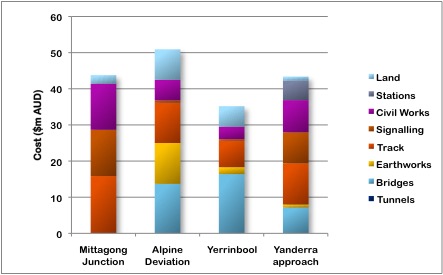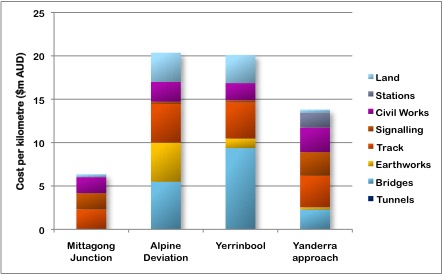← Bowral / Mittagong Previous | Next Upper Nepean→
As we get closer to Sydney, the Southern Highlands constricts down to a narrow spit of cleared land nestled between the Blue Mountains on the west and the Upper Nepean gorge on the east, and almost all of the transport infrastructure squeezes into a narrow 500m-wide band between Yerrinbool and Bargo. This limits the room available for deviations but also gives us a choice of several existing corridors to utilise. In particular, the Hume Highway presents an attractive option, with sweeping, large-radius curves and a wide median strip. The existing railway, a torturous route with minimum radius 360m, is mostly unsuitable for co-utilisation.
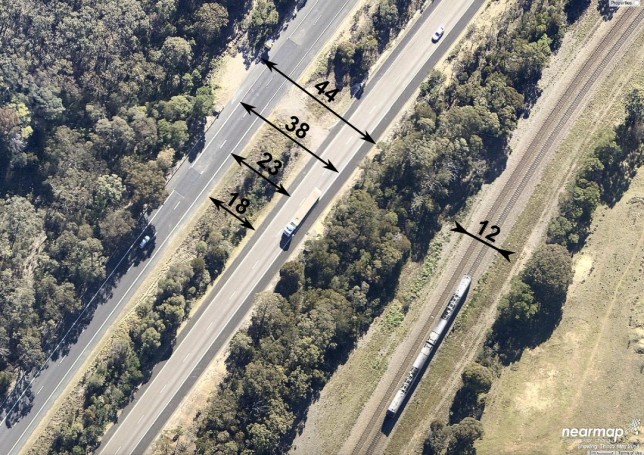
Dimensions in metres for Hume Hwy and adjacent railway near Yerrinbool. Base image: Nearmaps
Alignment design
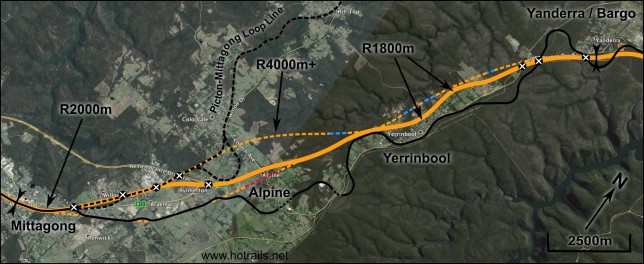
Yerrinbool plan – click to enlarge. The primary option (solid yellow line) follows the Hume Highway for much of its length.
The low-hanging fruit would have to be simply to bring the railway into the median strip of the highway as soon as possible, and to follow it from there. This would minimise design difficulty, and eliminate the expense and political difficulty of acquiring new land. Would this be a suitable solution? For starters, would a double-track railway fit within the existing constraints of the freeway corridor? The aerial imagery from www.nearmap.com shows that it would; the grassed median strip of the Hume Highway is about 18m in width, while the adjacent rail track is only 12m wide (including ballast apron). Fast train alignment might require slightly wider separation between tracks (for example, the VFT specified a perway width of about 13.6m, but that included room for OHLE supports). This would leave 3m on each side for concrete traffic barriers and other infrastructure (possibly even sufficient room for an access track, but as explained previously access tracks are unnecessary).
The earliest we could reasonably access the Hume corridor is near the small town of Alpine (pictured below). With some modifications, the disused Picton-Mittagong Loop Line can effect exit from Mittagong at high speed, allowing us to join the Hume at Aylmerton, slightly to the south of Alpine. The cost of railway construction in the median would be reasonable; it would comprise:
- Dual track: $2.25m/km
- 2x concrete barriers: $700k/km
- Drainage: $200k/km
- Signalling and control: $127k/km
- TOTAL: $3.28m/km (not including grade separations, bridges, traffic restrictions during construction, vegetation removal, etc)
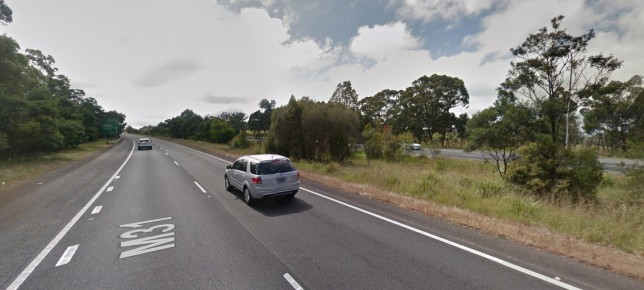
Northbound view, Hume Highway at Alpine, NSW. Photo: Google Streetview
With a minimum radius of about 1800m, being sufficient for tilting trains to achieve speeds of 250-300km/h, the horizontal alignment of the Hume Highway is suitable for Hot Rails’ purposes. Unfortunately and perhaps unsurprisingly, the vertical alignment is too steep for rail in some places. Between Alpine and Yerrinbool, the Hume Highway descends 150m in 4km, reaching a peak grade of 5.2%. This substantially exceeds our exceptional maximum of 3% – way more than we could compensate for by elevating or entrenching portions of the track to alleviate the slope – so an altogether new alignment with gentler gradient will have to be sought, at least between Alpine and Yerrinbool.
Alpine is located on a ridge running approximately east-west (Church Avenue follows the ridgeline). There are two broad options to reduce the severity of the gradient between here and Yerrinbool: First, an easterly option follows the existing mainline for a further 5.5km out of Mittagong, then proceeds in a tunnel under Alpine to join the Hume Highway. This tunnel would have to be at least 1250m in length, therefore costing over $75 million on its own, probably more like $100m. Best to avoid this option if there is a better one.
The second, westerly option follows the Picton Loop for a further 2.3km past Braemar (where our baseline option departed the corridor), utilising part of the even older, abandoned Picton Loop alignment through Colo Vale, then proceeding through the Bargo River Conservation Area with some length on viaduct (probably about 600-750m in total), joining the Hume Highway corridor just to the south of Yerrinbool. This keeps the grade to 3.0% without tunnels. This western option has the further advantage of being able to keep minimum radius above 4000m if, instead of joining the Hume median strip, a new rail corridor is established generally to the west of the existing highway.
1 – Mittagong station to Colo Vale – 6.35km
Beginning at Mittagong Station, this section follows the existing dual-track railway for approximately 1.5km to Mittagong Junction, where it deviates from the mainline to follow the former alignment of the Picton Loop Line. After passing under the Illawarra Highway, the line passes through the Highlands Golf Club, cutting off access to the second hole (an analysis of satellite imagery suggests there is sufficient un-utilised area within the course grounds to establish another hole). 4.7ha must be acquired from the golf course, as well as installation of tall netting to protect trains from wayward golf balls. Subsequently the alignment continues through Willow Vale and Braemar on the existing, almost-straight corridor, passing under the Railway Tce, Braemar Ave and finally the Hume Highway. The section ends at Colo Vale.
2 – The Alpine Deviation – 4.95km
Deviating from the Picton Loop corridor at the end of the straight section, the alignment proceeds northwesterly across Church Avenue onto farmland and then bush. Perhaps 6 houses will have to be demolished. A new corridor will be established through the southern end of Bargo River Conservation area, with alienated parkland compensated for by adding to the area of the park elsewhere. A 420m viaduct with 27.5m mainspan is required to ease gradient with a minimum of environmental impact. The line joins the Hume Highway corridor on the western side, with the section ending adjacent the service road immediately north of Hambridge Road.
3 – Yerrinbool – 3.25km
Starting 11.3km into the sector, the line proceeds straight through the less-densely settled western part of Yerrinbool, with grade separations required at Cascade Crescent and Sierra St. Another six or so properties will need to be acquired, at a probable cost of perhaps $800,000 each judging by properties currently advertised for sale in the area. Two fairly steep creeks will need to be traversed on bridge, the first 250m in length and the second 300m, with each comprised of 20m spans. The section ends at the northernmost extent of Western Rd.
4 – Approach to Yanderra / Bargo – 4.45km
Starting 14.6km into the sector, the line proceeds across farmland and bush with some minor earthworks, easing the curve between Yerrinbool and Yanderra to a radius of well over 4000m. The transition length between this curve and the previous one is about 2.7km, being more than sufficient; only 5 seconds is required for a train to tilt from one extreme to the other, and even at 300km/h it would take a train over 30 seconds to travel this distance. The track passes through Yanderra between Remembrance Drive and the Hume Highway; a small commuter station will be built near Yanderra Rd to allow commuters to change to the existing suburban rail service.
Summary
This adds up to a total cost of $173.25 million, or $9.12m/km. Broken down by section and type of expenditure, this is what it looks like:
The high cost of the middle two sections is largely due to the bridges, but also substantial earthworks in the case of the Alpine Deviation. As noted before, the expense is unavoidable in the case of the first and second sections – the other options are either too steep, or involve incredibly expensive tunnels. At under $10m/km, the Yerrinbool sector has come in below the typical average for Hot Rails upgrades.
Cheaper (but slower) option
In the case of the third and fourth sections, a potentially cheaper but slower option would be to access the Hume Highway median strip instead of building a new alignment between Yerrinbool and Yanderra. This would be politically simple and cheap to implement; the cost would be:
- Total cost of two sectors $29.0m, comprising:
- 7.7km of track, barriers, drainage and signalling: $25.3m
- 3 minor grade separations: $3.75m (total)
- Yanderra Station: Eliminated (no room to build in middle of highway)
This is versus $78.6m for the faster option. Saving almost $40m is pretty nifty, especially since the tilt trains will still be capable of running 250km/h on this alignment. However we’ve forgotten something important – how do we get the track from west of the Hume Highway to on the median strip?
Well, by a bridge or a tunnel, obviously. But we can’t just use our generic “complex grade separation” assumption here – the crossing is at an extremely shallow skew angle, meaning the span of the bridge will have to be large. And that’s expensive.
Below is an illustration of a possible alignment entering the Hume Highway median strip at Yerrinbool, almost in the exact same location as our example of highway dimensions above:
According to my cost functions for bridges, 300m of bridge with a 150m mainspan will cost over $42 million on its own, wiping out the savings in one hit. If we go for a 150m tunnel instead, the cost will be a much lower (but still substantial) $9.3 million. We would have to add to this extra costs for tunnel approach cuttings (or bridge approach embankments for that matter), as well as retaining walls for the median-strip side, as there would be insufficient room on the median strip for a standard 1.5-to-1 sloped cutting. All of this is going to seriously eat into the $40 million savings we started with. Perhaps a conservative estimate might be that this option could save $20 million over the fast option. An 11.6% saving on one sector only isn’t particularly impressive, but we’ll reserve judgement for the median strip option until we’ve analysed the following few sectors – at only $3.3m/km the benefits will add up quickly if we can stay on the highway for a decent distance.
NOTE: In this and future posts, I will avoid detailed descriptions of the cost components in each rail section – this is to keep the post itself relatively non-technical and uncluttered for general readers (as well as to avoid the need for me to write a highly tedious and mostly unnecessary part of each blog post – hopefully this will assist in increasing the frequency of said posts). Instead, graphical and tabular summaries of cost components shall be shown. Detailed information will still be available as an Excel spreadsheet on the railway summary page for those readers who are interested.






